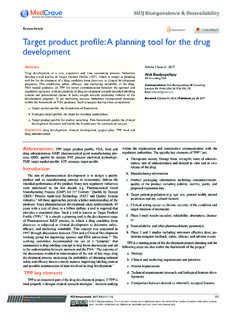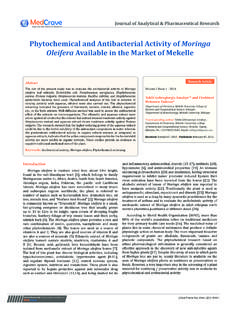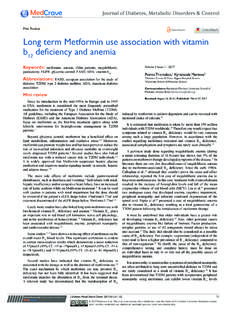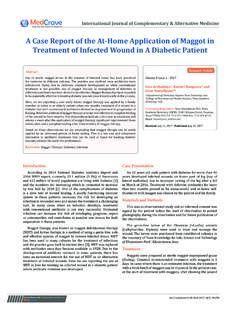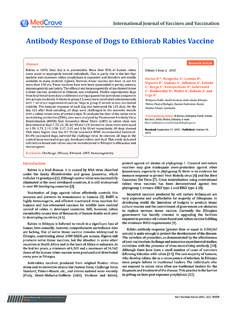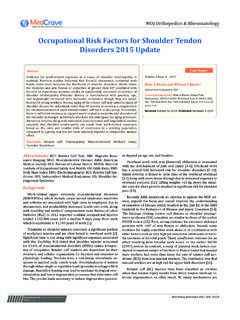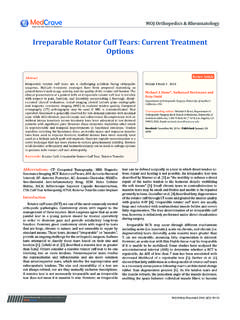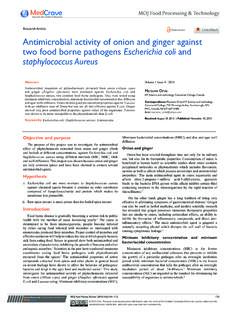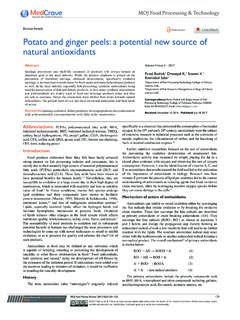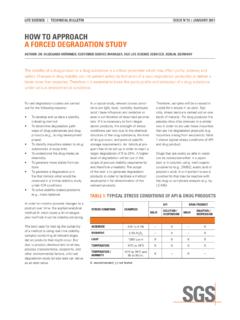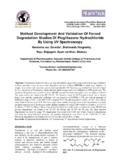Transcription of Forced Degradation Studies - Medcrave
1 Journal of Analytical & Pharmaceutical Research Forced Degradation Studies Abstract Mini Review Forced Degradation Studies include the Degradation of new drug substance and Volume 3 Issue 6 - 2016. drug product at conditions more severe than accelerated conditions. These Studies illustrate the chemical stability of the molecule which further facilitates the development of stable formulation with suitable storage conditions. ICH. guidelines demonstrate certain Degradation conditions like light, oxidation, dry heat, acidic, basic, hydrolysis etc. ICH Q1A, QIB and Q2B exemplify the Forced Department of Pharmaceutical Chemistry, Jamia Hamdard Degradation Studies . This review overviews the strategic approaches and trends (Hamdard University), India in Forced Degradation Studies .
2 *Corresponding author: Asif Husain, Department of Keywords: Degradation ; Drug substance; Stability; Safety; Testing; ICH Pharmaceutical Chemistry, Faculty of Pharmacy, Jamia guidelines, FDA Hamdard (Hamdard University), New Delhi, India, Email: Received: November 01, 2016 | Published: December 14, 2016. Introduction Outcomes of Forced Degradation Studies Forced Degradation Studies provide the approach to analyse Forced Degradation Studies offer the following information the stability of drug samples in pharmaceutical industries. Drug [2,3,10]: product safety and efficacy is affected by the chemical stability a. Determination of likely degradants, of the molecule. Stability of molecule information provides the data for selecting proper formulation, package, proper storage b.
3 Determination of Degradation pathways, conditions and shelf life. These data also play a significant role which is required in the regulatory documentation. Before filling c. Determination of intrinsic stability of the drug molecule, registration dossier it is obligatory to execute stability Studies of d. Determination of validated stability indicating analytical new drug molecules [1,2]. methods. International Conference on Harmonisation (ICH) guidelines, Regulatory guidelines make it essential to organize the Forced Degradation Studies and it is evidently mandated to perform Forced Degradation of new drug Various International guidelines recommended Forced products. These Studies offer the information to support detection Degradation Studies ICH guidelines sometimes apply only to the of potential degradants.
4 It also illustrates the Degradation pathways marketing applications for new products and do not cover the of pharmaceutically active molecules. The drug molecule intrinsic part during clinical development. The ICH guidelines that are stability can be estimated by Forced Degradation Studies . Probable applicable to Forced Degradation Studies are [1,6,10]: polymorphic or enantiomeric substances and variation between a. ICH Q1A: Stability Testing of New Drug Substances and drug related Degradation and excipients interferences can also Products, be evaluated by Forced Degradation Studies [3,4]. ICH guidelines mandatory oblige the Forced Degradation Studies under a range b. ICH Q1B: Photo stability Testing of New Drug Substances and of conditions, like pH, light, oxidation, dry heat, acidic, basic, Products, hydrolysis etc.
5 Moreover, it provides the separation of drug from c. ICH Q2B: Validation of Analytical Procedures: Methodology. Degradation products. The FDA and ICH guidance mandate the requirement of Forced Degradation to recognize how the quality of ICH Q1A (Stress testing): Recommended conditions for a drug substance and drug product varies with time and different performing Forced Degradation Studies on drug substances and environmental factors [5,6]. drug products. The recommendations are to inspect the results of temperature (above that for accelerated testing, , >50 C), The developed and validated analytical method permits the humidity (75% relative humidity), oxidation and photolysis.
6 Analysis of each Degradation products. Unfortunately, there Wide pH range should be considered in the testing of solution or is less guidance available to establish true selective Forced suspension. Ultimately the stability-indicating method developed Degradation methods. Appropriate experimental conditions for by these samples [2,11]. Forced Degradation Studies (temperatures, duration, and extent of Degradation , etc.) are not specified properly. This review provides ICH Q1B: Recommended approaches to assessing the photo an overview of Forced Degradation under variety of environmental stability of drug substances and drug products. For drug substance factors [7-9]. and drug product Forced Degradation conditions are specified in Submit Manuscript | J Anal Pharm Res 2016, 3(6): 00073.
7 Copyright: Forced Degradation Studies 2016 Iram et al. 2/5. Section II and Section III respectively. Forced Degradation Studies accelerated stability Studies (6months). But intermediate Studies exposure levels are not defined. Solid or in solution/suspension, (6months) can be performed at conditions lesser than that used photo stability testing can be performed. These samples are in accelerated Studies . After stability Studies the separation, then used to develop a stability indicating method. Some of the identification and quantitation are carried out [18,19]. Degradation products formed during Forced Degradation Studies Forced Degradation in pre-clinical phase or phase I of clinical may not really be experiential to form during stability Studies in trial is encouraged, which provides sufficient time for identifying which case they need not be examined further [1,12].
8 Degradation products, structure elucidation and optimizing the ICH Q2B: Gives guidance to validate the analytical methodology. stress conditions [20-22]. Improvement in the manufacturing To prove specificity, in section B (impurities not available) process and proper selection of stability-indicating analytical there is a suggestion to utilize samples from Forced Degradation procedures is obtained by early Forced Degradation Studies . Studies . Whether the analytical method is stability indicating or According to FDA the Forced Degradation Studies performed not specificity' is a key factor [6]. [20,23]: ICH Q3A (R2): with respect to both chemistry and safety prospects During pre-IND: During formulation Studies : stability indicating the identification of each impurity is required.
9 The chemical quality attributes, Degradation routes. For pre-clinical Studies : prospects include classification and identification of impurities, degradants, identification of toxic components report creation, catalogue of impurities in the specification and During clinical development: a concise discussion of analytical methods. The safety prospects include specific guidance for qualifying those impurities that a. Comparing pre-clinical to clinical quality were not present or were present at significantly minor levels in batch of a new drug substance [11-13]. b. Comparing pre- to post- manufacturing changes Objective for Forced Degradation [5,14-16]: c. In-use stability a. To develop Degradation pathways of drug substances and Post-marketing: usually Studies are not performed but drug products.
10 Following points considered- b. To recognize the chemical properties of drug molecules. a. Identified new stresses c. To elucidate the structure of Degradation products. b. Manufacturing changes d. To resolve stability-related problems c. Additional indications e. To establish the intrinsic stability of a drug substance in the Strategic development of Forced Degradation : formulation. The structural multiplicity of drug molecules makes it difficult f. To reveal the Degradation mechanisms of the drug substance to develop the generic set of conditions for a Forced Degradation and drug product. study. The selected stress conditions should be reliable with the product's decomposition [8].
